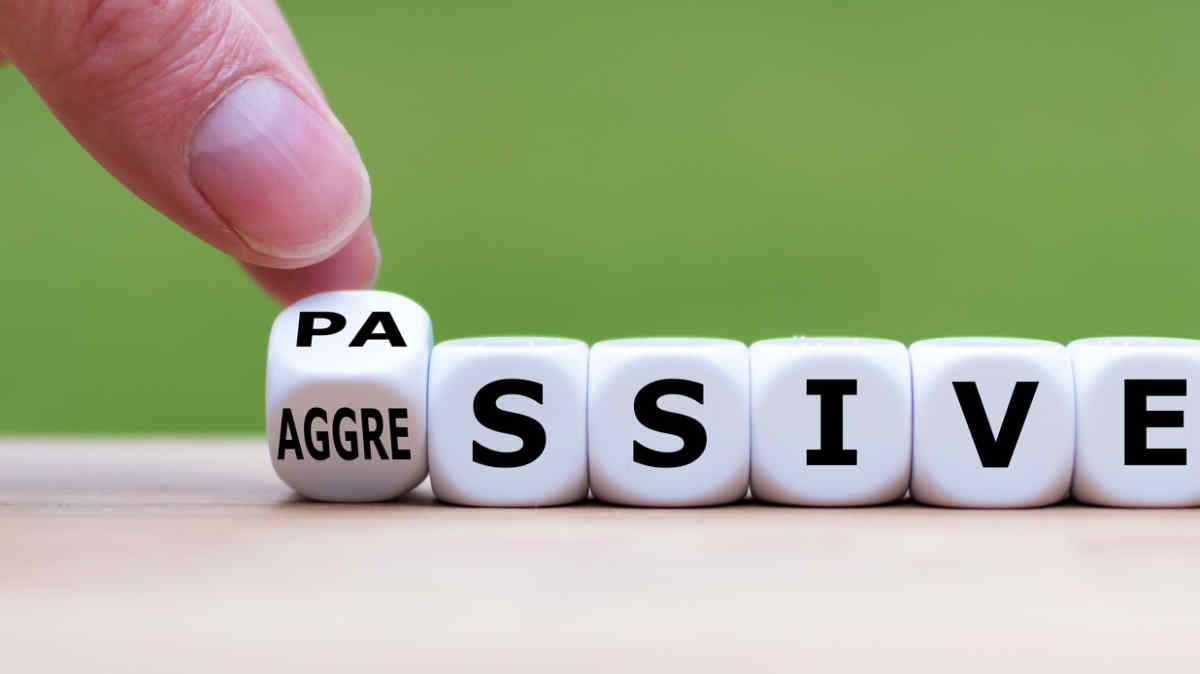Passive-Aggressive Behaviour
Passive-aggressive behaviour is when you are angry or upset with someone, but do not or cannot tell them. It is the inability to express difficult feelings in a rational way and can often make the problem worse. For the person on the receiving end, it can be incredibly frustrating and upsetting.
While some passive aggression can be unintentional (most of us will have behaved in this way at some point to avoid conflict) generally, the behaviour is intentional.

What is passive-aggressive behaviour?
Passive-aggressive behaviour can manifest in many different ways. Someone who is passive-aggressive may show resistance when asked to do something, through procrastination, disagreement or by being stubborn. They may refuse to be emotionally open even if they are apparently angry or upset, they will insist they are fine, shutting down the conversation. They may even make excuses to avoid certain people.
Instead of communicating honestly when you feel upset, annoyed, irritated or disappointed you may instead bottle the feelings up, shut off verbally, give angry looks, make obvious changes in behaviour, be obstructive, sulky or put up a stone wall. It may also involve indirectly resisting requests from others by evading or creating confusion around the issue.
A passive-aggressive might not always show that they are angry or resentful. They might appear in agreement, polite, friendly, down-to-earth, kind and well-meaning. However, underneath there may be manipulation going on – hence the term “passive-aggressive”.
Passive aggression is often considered a very destructive form of behaviour. When things aren’t spoken about, the problem can only get worse – like a rot that is spreading. It is persistent and can eat away at the trust between people, breaking down many relationships.
The different types of passive-aggressive behaviour
Passive-aggressive behaviour can vary in severity, frequency and intentionality.
When a person with a passive-aggressive personality is given a task that they do not agree with, they will appear positive and agreeable. But inside, they may be furious. Instead of making a fuss, they will find other ways to vent their frustration.
Common types of passive-aggressive behaviour include:
Intentional ineffectiveness
Imagine you’re given a task by your boss that you sincerely disagree with. You’ve been backed into a corner and can see no way out without risking your job or your working relationship, so you intentionally approach the task with laziness.
You may make subtle mistakes that are noticeable enough to aggravate your boss, but not so bad to warrant punishment. This gives you a sense of power and satisfaction in an otherwise powerless situation and is an underhand way of expressing your lack of care or attention to the task.
Intentional delays and forgetfulness
If you’re a passive-aggressive person, you may believe that going head to head with a controlling person is a recipe for failure. If you lack confidence in your ability to communicate, persuade and gain the approval of others, it’s likely you’ve learnt other ways to enforce power. A common form of passive aggression is to exaggerate the characteristics you know they find frustrating. You may demand their attention by being intentionally messy, forgetful or unorganised.
For example, a friend invites you out for dinner but continues to remind you of the time, insisting on reminding you again and again. To express frustration, a passive-aggressive individual will purposely turn up late. While others may consider this disrespectful, a passive-aggressive individual will see this as a small victory.
Sulkiness
Instead of putting up a fight or arguing, a passive-aggressive person is likely to become sullen, cold and withdrawn. Imagine being out with your partner and noticing them looking briefly at someone else. Instead of confronting them, you become emotionally closed. They have no idea why you are being so unresponsive, which in turn causes them to feel tense. This kind of behaviour can very easily spiral into a long-term standoff which brews and festers, growing into something far more destructive than it should have been.

Dealing with passive aggression
Passive-aggressive behaviour in any situation can be upsetting. Someone at work may exhibit these behaviours, which can make your work-life very uncomfortable. Your partner may be passive-aggressive, or a friend or family member, which can negatively impact not just your relationship, but your happiness and overall well-being.
While there is no one way of dealing with passive aggression, because the behaviour and the reasons behind it will vary for the person, however, it can help to know how to deal with this behaviour in the moment, and what you can do to support the person showing these behaviours
Passive-aggressive partners
Being in a romantic relationship with a passive-aggressive person is not easy. Loving relationships require honesty, openness and trust to work in the long-term, as do friendships. Unfortunately, these are characteristics that many passive-aggressive people find difficult, and so, the way they behave can put tension on the relationship.
In relationships, passive-aggressive personalities may appear cold and defensive, secretive, untrustworthy, easily aggravated and frightened of rejection or abandonment.
While we know the behaviours are indicative of underlying insecurities and feelings that are difficult to express, dealing with this behaviour takes a lot of understanding and patience. If you recognise passive-aggressive behaviours in your partner, know that help is available and there are ways you can support them. However, it’s important you do your research prior to approaching them, so to speak openly and without judgement.
Consider the following:
Try not to feel like their behaviour is a personal attack on you. Remember that this behaviour may be a sign of deeper issues, such as fear of rejection. They may love you dearly but remain distant due to the fear that you will leave them.
Be patient with them. If they feel attacked, they may get defensive and close off further.
Don’t be overbearing. Remember that passive-aggressive people are often resentful of authority. Instead, show them that you respect their opinions and ideas.
Talk to each other. If something has upset either of you, be open and be blunt in talking about it. Instead of leaving it to build, discuss it there and then. Passive-aggressive people struggle to express how they are feeling, so they may find your approach refreshing.
Look after yourself. Living and loving a passive-aggressive person can be very difficult and sometimes, it’s best to walk away. Your health comes first and while they may have their own reasons for behaving this way, it’s down to them to deal with them.
Passive-aggressive colleagues
Passive aggression in the workplace can be extremely destructive for not only productivity but general company morale. Managing an individual with passive-aggressive tendencies can be a massive, often frustrating challenge for any team leader or manager.
For people exhibiting these behaviours, it may be that they were suppressed or put down a lot as children. As they grow up, they have come to dislike authority. This sense of resentment can be difficult to shake, and so they can make working with them a challenge.
Common signs of a passive-aggressive employee include feeling under-appreciated, lack of accountability and blaming others, procrastination or poor time management, appearing irritable without reason and commonly using notes or emails to communicate in difficult situations, rather than speak face to face.
Dealing with a passive aggressive employee:
- reward good work
- show appreciation for what they do and let them know they are valued in the team
- be clear with expectations and boundaries from the beginning
- where possible, give them an element of choice and control in the work they do
- have regular meetings to check in, and speak about any concerns they have
Are you passive-aggressive?
Passive-aggressive behaviour is typically triggered by a desire to please people. Reasons include wanting to keep the peace, avoid mistakes, trying to appear more confident and authoritative or being afraid of rejection or criticism. However, because passive aggressive people are naturally unwilling to expose their true feelings, it can be difficult to understand the reasons behind their behaviour.
Whatever the deeper reason behind their hiding how they feel, passive aggressive people may instead be seen as rude, stubborn, careless, lazy, bitter, manipulative and close-minded.
If you recognise signs of passive aggression in your own behaviour, or you are worried about someone you know, help is available. We all show these behaviours from time to time, but if it’s negatively affecting your own, or someone else’s well-being, support may be needed.
Managing behaviour
Many people will display passive aggression at some point. Most people don’t like conflict and will avoid it where possible, and passive aggression is one of the ways we learn to deal with these situations. And in some situations, it is appropriate to keep emotions to yourself until you’re in a safe, private space.
If you recognise any of the passive-aggressive personality traits in yourself or someone you know, it is recommended you seek professional support. There are so many reasons why you or someone you know is behaving a certain way, and it may be that they need support.

The thing to remember is to be aware of your behaviour. When you think you’ve behaved in a passive aggressive way, consider what happened and why. Once you understand what is bothering you, you can begin to form a reasonable answer in your head. When you have an idea of the things that cause upset or anger, you can begin to explore the different ways you can address the situation in future.
Imagine a problem. Perhaps you’ve noticed your partner spending more time than usual on their phone, and you suspect they are talking to a past love interest, you need to consider your options. While tempted to ignore them for the next few days or take their phone and send a message in retaliation, this kind of behaviour will only cause more problems.
The way to understand what’s going on is to talk about it.
Be casual and try not to sound accusing.
Be honest and tell them you’re worried. This lack of trust needs to be addressed, whether it’s your own doubt or something more serious.
If what you suspect is true, ask them why and explain why you think it is unacceptable behaviour.
Forcing yourself to be frank, honest, sympathetic and tactful is always going to reap healthier rewards than being cold, defensive and vindictive. More often than not, other people will have no idea why you are upset about something. Instead, you may appear difficult and people will find it hard to warm to you. This can be upsetting for everyone involved and often, the person showing passive-aggressive behaviour becomes isolated.
Learning to express how you feel in a positive, constructive way can help deepen your relationships with people. Talking about how you feel and expressing yourself when someone has upset you isn’t easy, but confronting the issue without conflict is possible.
Changing such deeply embedded behaviours takes time. If your behaviour is affecting relationships, work-life or your mental health, seeking professional help from a qualified counsellor or therapist can help. Speaking in a safe, confidential space can allow you to not only understand your behaviours and what caused them, but take the steps to rebuild your trust, and learn how to express feelings in an honest, healthy way.
Counselling
Counselling for passive-aggressive behaviour can often be an extremely delicate process. This is because people who display this form of behaviour do not react well to being ordered to think in a certain way or reveal certain specific details about themselves. Remember, passive-aggressive people often spend their whole lives denying or repressing their true feelings and opinions, so opening up will take time. Often, they will go out of their way to expose the source of authority as ineffective or incompetent.
Some counsellors believe that in order to tackle our behaviours, we must revisit our childhood. We must learn how we became the people we are today and identify the events that triggered certain insecurity, fears and anxieties.
Once you understand potential triggers and the reasons behind your behaviour, together with your counsellor, you can learn how to manage these feelings and express them in a healthy way.
Cognitive behavioural therapy (CBT) is a popular therapy used to help clients understand their thoughts and behaviours, and learn how to change them.
CBT combines two different approaches for practical and solution-focused therapy. The therapy is very active by nature, so you may be expected to take a proactive role within your treatment. This may include completing tasks at home.
The idea behind CBT is that our thoughts and behaviours will influence each other. The premise is that, by changing the way we think or behave in a situation, we can change the way we feel about life. The therapy examines learnt behaviours, habits and negative thought patterns with the view of adapting and turning them into a positive.